| Süleymaniye Mosque | |
|---|---|
Süleymaniye Camii | |
 Süleymaniye Mosque | |
| Religion | |
| Affiliation | Islam |
| Location | |
| Location | Istanbul, Turkey |
 Location in the Fatih district of Istanbul | |
| Geographic coordinates | 41°00′58″N 28°57′50″E / 41.01611°N 28.96389°E |
| Architecture | |
| Architect(s) | Mimar Sinan |
| Type | Mosque |
| Style | Ottoman architecture |
| Groundbreaking | 1550 |
| Completed | 1557 |
| Specifications | |
| Height (max) | 53 m (174 ft) |
| Dome dia. (inner) | 26 m (85 ft) |
| Minaret(s) | 4 |
| Minaret height | 76 m (249 ft) |
| Part of | Historic Areas of Istanbul |
| Criteria | Cultural: i, ii, iii, iv |
| Reference | 356 |
| Inscription | 1985 (9th Session) |
The Süleymaniye Mosque (Turkish: Süleymaniye Camii, pronounced [sylejˈmaːnije]) is an Ottoman imperial mosque located on the Third Hill of Istanbul, Turkey. The mosque was commissioned by Suleiman the Magnificent and designed by the imperial architect Mimar Sinan. An inscription specifies the foundation date as 1550 and the inauguration date as 1557. Behind the qibla wall of the mosque is an enclosure containing the separate octagonal mausoleums of Suleiman the Magnificent and his wife Hurrem Sultan (Roxelana). For 462 years, the Süleymaniye Mosque was the largest mosque in the city, until it was surpassed by the Çamlıca Mosque in 2019. The Süleymaniye Mosque is one of the best-known sights of Istanbul, and from its location on the Third Hill, it commands an extensive view of the city around the Golden Horn.
History

Sultan Suleyman the Magnificent chose the architect Mimar Sinan to create a mosque in memory of his son Şehzade (Crown Prince) Mehmed. Suleyman was so impressed with the ensuing Şehzade Mosque (Şehzade Cami) that he asked Sinan to design a mosque for himself too. This mosque would represent the pre-eminence of the Ottoman Empire.[1] In designing the Süleymaniye Mosque, Sinan took inspiration from the Hagia Sophia and the Bayezid II Mosque. [2] The mosque was built on the site of the old palace (Eski Saray) of Topkapi which was still in use at the time and had to be demolished. [3]
The Arabic inscription above the north portal of the mosque is carved in Thuluth script on three marble panels. It gives a foundation date of 1550 and an inauguration date of 1557. In reality the planning of the mosque began before 1550 and parts of the complex were not completed until after 1557.[4]
The design of the Süleymaniye played on Süleyman's self-conscious representation of himself as a 'second Solomon.' It referenced the Dome of the Rock, which was built on the site of the Temple of Solomon in Jerusalem, as well as Justinian's boast upon the completion of the Hagia Sophia: "Solomon, I have surpassed thee!"[5] The Süleymaniye asserted Süleyman's historical importance although it was smaller in size than Hagia Sophia.
The Süleymaniye was damaged in the great fire of 1660 and was restored by Sultan Mehmed IV.[6] Part of the dome collapsed during the earthquake of 1766. Subsequent repairs damaged what was left of Sinan's original decoration (recent cleaning has shown that he experimented with blue, before making red the dominant colour of the dome).[7]
During World War I the courtyard was used as a weapons depot, and when some of the ammunition ignited, the mosque suffered another fire. Not until 1956 was it fully restored again. The mosque was restored again between 2007 and 2010.[8] Parts of the surrounding complex continued to be restored in the decade following.
Architecture
Exterior
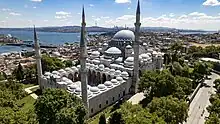
Like the other imperial mosques in Istanbul, the entrance to the mosque is preceded by a forecourt with a central fountain. The courtyard is of exceptional grandeur with a colonnaded peristyle with columns of marble, granite and porphyry. The northwest facade of the mosque is decorated with rectangular Iznik tile window lunettes.[9] It was the first building in which the Iznik tiles included the brightly coloured tomato red clay under the glaze.[10]
Four minarets occupy the four corners of the courtyard. The two taller ones have three galleries (serifes) and rise to a high of 63.8 m (209 ft) without their lead caps and 76 m (249 ft) including the caps.[11] Four minarets were added to mosques endowed by a sultan (princes and princesses could construct two minarets; others only one). The minarets have a total of 10 galleries, which is said to reflect the fact that Suleiman I was the 10th Ottoman sultan.[12]
The main dome is 53 metres (174 feet) high and has a diameter of 26.5 metres (86.9 feet) which is exactly half the height.[13] When it was built, it was the highest dome in the Ottoman Empire, when measured from sea level, although it was still lower from its base and smaller in diameter than that of Hagia Sophia.
 North facade with the forecourt and central fountain (şadırvan)
North facade with the forecourt and central fountain (şadırvan) Courtyard of the mosque
Courtyard of the mosque
Interior
The interior of the mosque is almost a square measuring 59 metres (194 feet) in length and 58 metres (190 feet) in width, forming a single vast space. The dome is flanked by semi-domes, and to the north and south there are arches with tympana-filled windows, supported by enormous porphyry monoliths. Sinan embarked on a radical architectural innovation to mask the huge north–south buttresses needed to support these central piers - he incorporated the buttresses into the walls of the building, with half projecting inwards and half projecting outwards, and then hid the projections by building colonnaded galleries. There is a single gallery inside the structure, and a two-story gallery outside.
The interior decoration is restrained, with stained-glass windows restricted to the qibla wall. Iznik tile revetments are only used around the mihrab.[14] The repeating rectangular tiles have a stencil-like floral pattern on a white ground. The flowers are mainly blue with turquoise, red and black but green is not used.[15] On either side of the mihrab are large Iznik-tile calligraphic roundels with text from the Al-Fatiha surah of the Quran 1:1-7 .[16]The white marble mihrab and mimbar are simple in design, and the woodwork is restrained, with simple designs in ivory and mother of pearl.
 Interior looking towards the mihrab
Interior looking towards the mihrab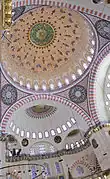 The mosque's central dome and semi-domes
The mosque's central dome and semi-domes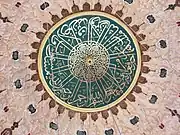 Closer view of the central dome
Closer view of the central dome
Mausoleums
In the walled enclosure behind the qibla wall of the mosque are the separate mausoleums (türbe) of Sultan Suleiman I and his wife Hurrem Sultan (Roxelana).
The large octagonal mausoleum of Suleiman the Magnificent bears the date of 1566, the year of his death, but it was probably not completed until the following year. The mausoleum is surrounded by a peristyle with a projecting roof supported by 24 columns; the entrance faces towards the east rather than the usual north.[17] Beneath the portico on either side of the entrance are Iznik tiled panels.[18] These are the earliest known tiles decorated with the bright emerald green colour that would become a common feature of Iznik ceramics.[19] The interior has a false dome supported on eight columns within the outer shell. There are 14 windows at ground level and an additional 24 windows with stained glass set in the tympana under the arches. The walls and pendentives are covered with polychrome Iznik tiles. Above the windows runs a band of inscriptive tiled panels.[20] The text quotes the Throne verse and the following two verses from the Quran 2:255-258.[18] In addition to the tomb of Suleiman the Magnificent, the mausoleum houses the tomb of his daughter Mihrimah Sultan and those of two later sultans: Suleiman II (ruled 1687–1691) and Ahmed II (ruled 1691–1695).[20][21]
Hurrem Sultan's octagonal mausoleum is dated 1558, the year of her death.[22] The 16-sided interior is decorated with Iznik tiles. The seven rectangular windows are surmounted by tiled lunettes and epigraphic panels. Between the windows are eight mihrab-like hooded niches.[18] The ceiling is now whitewashed but was probably once painted in bright colours.[20]
There is also a large graveyard containing the tombs of notable figures including Gazi Osman Paşa and Mimar Kemaleddin.
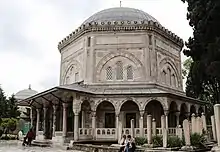 Mausoleum of Suleiman the Magnificent
Mausoleum of Suleiman the Magnificent
Complex
As with other imperial mosques in Istanbul, the Süleymaniye Mosque was designed as a külliye, or complex, with adjacent structures to service both religious and cultural needs. The mosque incorporates the everyday needs for civilisation such as prayer, education, health and much more.[3] The original complex consisted of the mosque itself, a hospital (darüşşifa), primary school (mekteb), public baths (hamam), a caravanserai, four Qur'an schools (medrese), a specialized school for the learning of hadith, a medical college and a public kitchen (imaret) which served food to the poor. Many of these structures are still in existence, and the former imaret is now a noted restaurant. The former hospital is now a printing factory owned by the Turkish Army.
Just outside the complex walls, to the north is the tomb of architect Sinan.[23] It was completely restored in 1922.[24]
Inscriptions
Religious inscriptions in parts of the mosque demonstrate its stature as a place of sacredness. Quranic messages can be found incorporated throughout the building. For example, the side entrance of the mosque has an inscription reading, "Peace be unto thee! Thou art good, so enter ye to dwell therein" (39:73)[25] On the Qibla wall, the stained-glass windows display the names of God (Allah), the Prophet Muhammad, and the caliphs. They are there to represent Allah as the lawmaker, Muhammad as the preacher, and the four caliphs as the four pillars. of Islam [25]
Gallery
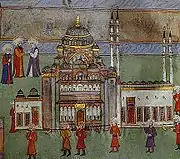 An Ottoman miniature of the Mosque
An Ottoman miniature of the Mosque Süleymaniye Mosque, 1890
Süleymaniye Mosque, 1890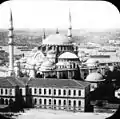 Exterior aerial shot of Süleymaniye Mosque, 1903. Brooklyn Museum Archives, Goodyear Archival Collection
Exterior aerial shot of Süleymaniye Mosque, 1903. Brooklyn Museum Archives, Goodyear Archival Collection Suleiman's mausoleum
Suleiman's mausoleum Mausoleum of Hurrem Sultan (Roxelana)
Mausoleum of Hurrem Sultan (Roxelana) Süleymaniye Mosque entrance to garden from west
Süleymaniye Mosque entrance to garden from west Süleymaniye Mosque western portal
Süleymaniye Mosque western portal Süleymaniye Mosque detail
Süleymaniye Mosque detail Süleymaniye Mosque from north side
Süleymaniye Mosque from north side Süleymaniye Mosque view from south side
Süleymaniye Mosque view from south side Süleymaniye Mosque domes from outside
Süleymaniye Mosque domes from outside Süleymaniye Mosque domes
Süleymaniye Mosque domes Prayer hall and chandelier
Prayer hall and chandelier Süleymanyiye Msoque: muezzin's gallery
Süleymanyiye Msoque: muezzin's gallery Süleymaniye Mosque courtyard at night
Süleymaniye Mosque courtyard at night Süleymaniye Mosque portico and one of the minarets at night
Süleymaniye Mosque portico and one of the minarets at night Süleymaniye Mosque window
Süleymaniye Mosque window Distant View Of The Suleymanie Mosque
Distant View Of The Suleymanie Mosque Interior of the Suleymanie Mosque displaying the Qibla wall and the mihrab.
Interior of the Suleymanie Mosque displaying the Qibla wall and the mihrab. Remote view of Süleymaniye Mosque
Remote view of Süleymaniye Mosque Süleymaniye Mosque Prayer Service, July 22, 2016.
Süleymaniye Mosque Prayer Service, July 22, 2016.
Tombs
- Suleiman I (1494–1566)
- Hürrem Sultan (c. 1502–1558), Suleiman's wife
- Mihrimah Sultan (c. 1522–1578) Suleiman and Hürrem's daughter
- Ahmed II (1642/43–1695)
- Rabia Sultan (d. 1712) Ahmed's consort
- Asiye Sultan (1694–1695), Ahmed and Rabia's daughter
- Suleiman II (1642–1691)
- Aşub Sultan (d. 1690) Suleiman's mother
See also
References
- ↑ Gabr, Aly (2001). "Rediscovery: Mimar Sinan, Suleyman the Magnificent & the Suleymaniye". Medina Magazine.
- ↑ Migeon, Gaston (2009). Art of Islam. Parkstone International. pp. lxxii.
- 1 2 Kuban, Dogan (1987). "Süleymaniye and Sixteenth-century Istanbul". Journal of the Islamic Environmental Design Research Centre 1-2: 4 – via archnet.org.
- ↑ Necipoğlu 2005, p. 208.
- ↑ Neci̇poğlu-Kafadar 1985, p. 103.
- ↑ Baer 2004.
- ↑ Goodwin 2003, p. 235.
- ↑ A.A (9 November 2010). "Süleymaniye Camii restorasyonunda sona doğru". www.hurriyet.com.tr (in Turkish). Retrieved 2022-08-24.
- ↑ Necipoğlu 2005, p. 217.
- ↑ Denny 2004, p. 79.
- ↑ Goodwin 2003, p. 226.
- ↑ Neci̇poğlu-Kafadar 1985, pp. 105–106.
- ↑ Goodwin 2003, p. 231.
- ↑ Necipoğlu 2005, p. 216.
- ↑ Denny 2004, pp. 86, 209.
- ↑ Necipoğlu 2005, p. 219 fig 183.
- ↑ Goodwin 2003, pp. 237–238.
- 1 2 3 Necipoğlu 2005, p. 220.
- ↑ Atasoy & Raby 1989, p. 230.
- 1 2 3 Goodwin 2003, p. 238.
- ↑ Sumner-Boyd & Freely 2010, p. 202.
- ↑ Goodwin 2003, p. 237.
- ↑ Necipoğlu 2005, pp. 150, 205 Fig. 167 (13).
- ↑ Goodwin 2003, p. 222.
- 1 2 Necipoglu, Gulru (1985). "The Süleymaniye Complex in Istanbul: An Interpretation". In Muqarnas III: An Annual on Islamic Art and Architecture: 110 – via archnet.org.
- Gabr, Aly (2001). "Rediscovery: Mimar Sinan, Suleyman the Magnificent & the Suleymaniye". In Medina Issue Seventeen: Architecture, Interiors & Fine Arts. British Virgin Islands: Medina Magazine.
- Ching, Francis (2017). A Global History of Architecture. John Wiley & Sons, Incorporated. p. 533.
- Migeon, Gaston (2009). Art of Islam. Parkstone International. pp.lxxii.
- Kuban, Dogan (1987). "Süleymaniye and Sixteenth-century Istanbul". Journal of the Islamic Environmental Design Research Centre 1-2: 4 – via Archnet.org.
- Necipoglu, Gulru (1985). "The Süleymaniye Complex in Istanbul: An Interpretation". In Muqarnas III: An Annual on Islamic Art and Architecture: 110 – via Archnet.org.
Sources
- Atasoy, Nurhan; Raby, Julian (1989). Petsopoulos, Yanni (ed.). Iznik: The Pottery of Ottoman Turkey. London: Alexandria Press. ISBN 978-1-85669-054-6.
- Baer, Marc David (2004). "The great fire of 1660 and the Islamization of Christian and Jewish space in Istanbul". International Journal of Middle East Studies. 36 (2): 159–181. doi:10.1017/S002074380436201X. JSTOR 3880030. S2CID 161640738.
- Denny, Walter B. (2004). Iznik: the Artistry of Ottoman Ceramics. London: Thames & Hudson. ISBN 978-0-500-51192-3.
- Goodwin, Godfrey (2003) [1971]. A History of Ottoman Architecture. London: Thames & Hudson. pp. 215–239. ISBN 978-0-500-51192-3.
- Neci̇poğlu-Kafadar, Gülru (1985). "The Süleymaniye Complex in Istanbul: an interpretation". Muqarnas. 3: 92–117. doi:10.2307/1523086. JSTOR 1523086.
- Necipoğlu, Gülru (2005). The Age of Sinan: Architectural Culture in the Ottoman Empire. London: Reaktion Books. ISBN 978-1-86189-253-9.
- Sumner-Boyd, Hilary; Freely, John (2010). Strolling through Istanbul. London: Tauris Parke. pp. 199–208. ISBN 978-1-84885-154-2.
Further reading
- Barkan, Ömer Lûtfi (1972–1979). Süleymaniye Cami ve İmareti İnşaatı (1550-1557) (in Turkish). Vol. (2 Volumes). Ankara: Türk Tarih Kurumu Basımevi. OCLC 614354340.
- Faroqhi, Suraiyah (2005). Subjects of the Sultan: Culture and Daily Life in the Ottoman Empire. London: I.B. Tauris. ISBN 1-85043-760-2.
- Kolay, İlknur Aktuğ; Çeli̇k, Serpi̇l (2006). "Ottoman stone acquisition in the mid-sixteenth century: the Süleymani̇ye Complex in Istanbul". Muqarnas. 23: 251–272. JSTOR 25482444.
- Morkoç, Selen B. (2008). "Reading architecture from the text: the Ottoman story of the four marble columns". Journal of Near Eastern Studies. 67: 31–47. doi:10.1086/586669. S2CID 161434861.
- Rogers, J.M. (2007). Sinan: Makers of Islamic Civilization. London: I.B. Tauris. ISBN 978-1-84511-096-3.
External links
- Süleymaniye Külliyesi, Archnet
- Süleymaniye Mosque ve Mimar Sinan (in Turkish)
- Suleymaniye Mosque Virtual Walking Tour, Saudi Aramco World.
- Photographs by Dick Osseman



.svg.png.webp)